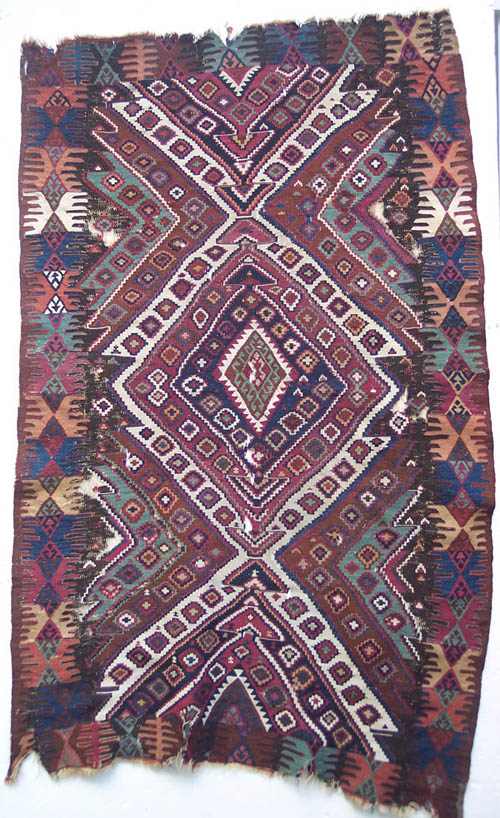Hi Joel,
I agree that the conglomeration
of rugs I posted muddles more than clarifies the picture. That’s really my
point. It’s probably not an accident that “true” Yuruk rugs are not well
identified or understood in the collective wisdom of rugdom. Apparently,
there isn’t a common group of designs, weaving style, palette, or other
characteristic that sets the true Yuruk apart from other rustic Anatolian
production. Rather, it seems that the several groups of nomadic peoples to
whom the name, “Yuruk,” is given produce a very diverse array of weavings.
I believe that circumstance accounts for the fact that no widely
recognized group of weavings produced by these peoples are called
"Yuruk."
Ironically, it is the weavings of another group, i. e.,
certain Kurds (not to be called “Yuruk” under any circumstances according
to Brüggemann and Böhmer), that do have a recognizable character and have
long since taken on the label, “Yuruk.” This historical fact probably
is an accident. Whether it was caused by Mumford, or merely
reported by him, is hard to say. But his description of what he called
“Yuruk” sounds very much like what are in my opinion the principal
recipients of the “Yuruk” label over the years.
Though many rustic
weavings from Turkey are apt to be called “Yuruk” from time to time, in my
experience there is a particular type of rug that is most often identified
by this name. The characteristics are many, and they are not necessarily
all present in any particular example, but there is a certain “Yurukness”
that is quite distinct. They are somewhat like Baluch rugs in this
respect…quite a range when you think about it, but you usually know when
you are looking at one. One prominent issue is the palette, which often
features cochineal red, a very characteristic burnt orange, and a powerful
mid-blue. The corrosive black one finds in them is usually very intensely
black. There tend to be many secondary colors, often unusual relative to
other rugs. Unfortunately, I don’t have a nifty example to put up, but
following is a slightly tattered kilim that uses a good bit of the
palette, including two oranges.

The rug you opened your essay
with is very Yuruk, though the handling characteristics are a bit off the
norm I am thinking of (I handled the rug at the sale from which you
purchased). The one I posted in frame #10 of the dimensions thread is also
very "Yuruk," though exhibiting atypical qualities of wool. That may be a
function of later production.
Looking at the other rugs that have
already been posted, the most typical example of what I have been talking
about would be the first of Alex's posts in frame #8 of your first thread.
The orange and the mid-blue are especially apt. Another prime Yuruk is the
black and white photo you posted from Jacobsen, the fourth image in frame
#12 of that thread. I am sure it exhibits the general palette I mentioned.
The shape of the hooks on those three vertical diamonds is very typical
for the group of Yuruks of which I speak.
Other recognizable
features of the central group of Yuruks are very soft, often glossy wool,
baggy shape (as shown by my kilim, above), and an advanced state of
suppleness and pliability. The chronic shape problems of Yuruk rugs are
said to be a function of nomad looms, staked on the ground and taken up
for transport in the middle of the weaving. That may be, but I think a
second factor is the use of relatively finely spun foundation materials to
support relatively stout pile yarns that accounts for some of the shape
problems of the rugs. I think these components also dictate the handling
qualities.
I don't know what groups of Kurds weave the Yuruks I
described, and it seems other Kurds in Turkey weave rugs with different
characteristics. Many of the rugs illustrated in these threads, and
elsewhere, attributed to Kurds of Eastern Anatolia around Kagizman, are
not what I would call Yuruk, though the label can find them as I suggested
above. In any case, I think the situation is complex around your
Yuruk/Kurd question. In this respect, I am reminded of Patrick's salon on
Shahsavan. He did a good job of pulling a number of characteristics out of
the barrel to define what seems to be a definable Shahsavan product. But
there seem to be several others as well, and no apparent consensus about
what is what. In those cases, the rubric, "Northwest Persian" has been
implemented to get past the confusion respectably. So, as you say, it will
be good if some knowledgeable folks can step in here and allay some of the
ignorance. However, it doesn't seem there are, or have been, too many of
that ilk. That's why we have the problem you astutely
identified.
Rich Larkin
P. S.: What do you think of the fact
that nowhere in the 1982 Baktiari Rug Co, calendar devoted to "Yuruk" did
the term, "Kurd," appear? Were you as shocked as I?